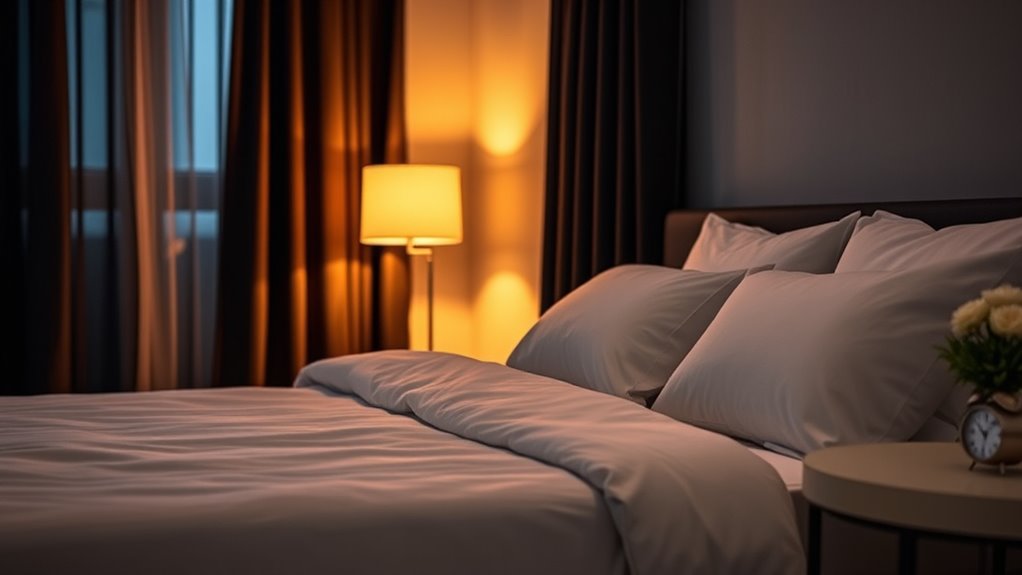To create a sleep-friendly environment, you should make your room quiet, dark, and cool, ideally between 60-67°F. Use blackout curtains or an eye mask to block out light and consider white noise or earplugs to reduce noise disruptions. Keep your space clutter-free and comfortable to minimize stress. Avoid screens before bed, as blue light interferes with melatonin. Focusing on these tips can help you achieve more restful sleep—exploring further can open even better habits.
Key Takeaways
- Keep your bedroom cool, dark, and quiet, using blackout curtains and white noise to promote restful sleep.
- Maintain a consistent sleep schedule to help regulate your internal clock and improve sleep quality.
- Minimize electronic screens and blue light exposure at least one hour before bed to enhance melatonin production.
- Create a clutter-free and calming environment to reduce stress and eliminate distractions before sleep.
- Incorporate relaxing routines like meditation or gentle stretching to signal your body that it’s time to wind down.

Getting quality sleep is essential for your overall health and well-being, but many people struggle to maintain good sleep habits. One key aspect of sleep hygiene involves creating an environment that promotes restful sleep, and that starts with understanding the importance of dream relaxation and bedtime routines. When your environment is conducive to sleep, your mind can shift more easily into a peaceful state. Dream relaxation isn’t just about what happens in your dreams; it’s about calming your mind before sleep so that your dreams can be more restorative. Establishing a consistent bedtime routine helps signal to your body that it’s time to wind down, making it easier to fall asleep and stay asleep longer.
Creating a restful environment and routine signals your body to relax and sleep better.
Your sleep environment should be quiet, dark, and cool. Darkness signals your brain to produce melatonin, the hormone responsible for sleep regulation. Use blackout curtains or an eye mask if necessary, especially if streetlights or electronic screens disrupt your sleep. Noise can be a barrier to achieving deep, uninterrupted rest, so consider earplugs or white noise machines. Keeping the room cool, around 60-67°F (15-19°C), helps your body reach the ideal temperature for sleep, promoting relaxation and reducing wakefulness during the night. Avoid clutter and distractions in your sleeping area; a tidy, calming space reduces stress and encourages a more peaceful state of mind at bedtime. Additionally, the increasing use of neural networks in sleep research is helping scientists better understand how environmental factors influence sleep quality.
Your bedtime routines play a crucial role in preparing your body and mind for sleep. Consistency is key—going to bed and waking up at the same times each day helps regulate your internal clock. Incorporate relaxing activities into your pre-sleep schedule, such as reading, gentle stretching, or listening to calming music. Avoid stimulating screens at least an hour before bed, as the blue light emitted can interfere with melatonin production. Instead, engage in activities that promote dream relaxation, such as meditation or deep breathing exercises, which can ease your transition into sleep and foster more restorative dreams.
Creating a sleep-friendly environment isn’t just about physical surroundings; it’s about establishing habits that cue your brain for rest. A predictable bedtime routine helps condition your mind to associate specific activities with sleep, reducing anxiety and racing thoughts that can keep you awake. By prioritizing a calm, comfortable environment and consistent routines, you set the stage for high-quality sleep, allowing your body and mind to fully recover overnight. Over time, these small changes can markedly improve your sleep quality, making you feel more refreshed and energized each day.
Frequently Asked Questions
How Does Room Temperature Affect Sleep Quality?
You’ll find that room temperature substantially impacts your sleep quality. When climate control maintains a cool, comfortable environment, your body achieves ideal thermal comfort, helping you fall asleep faster and stay asleep longer. Excessively warm or cold rooms disrupt sleep cycles and cause discomfort. Aim for a room temperature around 60-67°F (15-19°C) to enhance your sleep, ensuring your environment supports restful, uninterrupted sleep through proper thermal comfort.
Can Aromatherapy Improve Sleep Environment?
Yes, aromatherapy can improve your sleep environment. Using essential oils with calming scents like lavender, chamomile, or ylang-ylang, you can create a relaxing atmosphere that signals your body it’s time to rest. Diffusing these oils or applying them topically helps reduce stress and anxiety, making it easier to fall asleep and stay asleep throughout the night. Incorporate aromatherapy into your bedtime routine for better sleep quality.
What Are Effective Noise Reduction Techniques?
To reduce noise, you can hang soundproof curtains that block out external sounds effectively. Using a white noise machine creates a consistent background sound, masking disruptive noises and helping you relax. Combining these techniques enhances your sleep environment, making it quieter and more peaceful. Remember, consistency in using these methods improves their effectiveness, so incorporate them into your nightly routine for better rest.
How Does Lighting Influence Melatonin Production?
Bright lighting suppresses melatonin production, making it harder for you to fall asleep, while darkness signals your body to produce more melatonin, encouraging rest. Light exposure, especially blue light from screens, can delay this process, disrupting your sleep cycle. To optimize melatonin levels, dim your environment before bed and avoid screens. This balance between light and dark is vital for healthy sleep patterns and restorative rest.
Are There Specific Bedding Materials That Promote Better Sleep?
Selecting the appropriate bedding materials can greatly enhance your sleep. Choose a mattress with the right firmness to support your body and reduce pressure points, helping you stay comfortable all night. Additionally, select a pillow that offers proper support for your neck and head. Breathable fabrics like cotton or bamboo can keep you cool and dry, promoting deeper rest. Prioritize these factors to create an ideal sleep environment.
Conclusion
By now, you’ve laid the foundation for a restful night, turning your bedroom into a sanctuary for sleep. Remember, good sleep hygiene is like tending a garden—consistent care yields beautiful blooms of rest. Keep your environment cool, dark, and quiet, and stick to a routine. Soon, restful nights will become your new normal, and you’ll wake up feeling refreshed and ready to conquer the day. Sweet dreams are just a few simple steps away.









